

The use of solar chimneys to increase ventilation in environments can reduce electric bills, bring thermal comfort and help preserve the environment, says research funded by FAPESP.
The use of solar chimneys to increase ventilation in environments can reduce electric bills, bring thermal comfort and help preserve the environment, says research funded by FAPESP.
The use of solar chimneys to increase ventilation in environments can reduce electric bills, bring thermal comfort and help preserve the environment, says research funded by FAPESP.

The use of solar chimneys to increase ventilation in environments can reduce electric bills, bring thermal comfort and help preserve the environment, says research funded by FAPESP.
By Mônica Pileggi
Agência FAPESP – Living in a country like Brazil, where each region has its own climate, can be good for some and bad for others. A study done at the Universidade Federal de São Carlos (UFSCar) on solar chimneys, however, could help cool those who live in hotter regions.
The solar chimney developed by professor Maurício Roriz and his students Fernando Sá Cavalcante and Letícia de Oliveira Neves at the UFSCar Center of Exact Sciences and Technology adopts the same principle as a solar water heater and can be installed to increase natural ventilation in homes or offices.
“The chimney works like a solar collector: the rays of the sun pass through glass and heat a black metal plate below. Once heated, the plate emits warmth, but in a different frequency than that which comes from the sun because the glass is opaque. So the heat enters, but can’t get out again,” Roriz told Agência FAPESP. In conventional solar heaters, the water heats as it circulates in tubes that pass below the hot plate. “In the solar chimney, instead of water, it is air that circulates,” he said.
This natural air conditioner is based on the “chimney effect”: inside the structure, the hot air becomes lighter and tends to rise, pulling air from internal spaces and substituting it with external air, which is cleaner and generally more comfortable, especially in typical Brazilian climates.
“It is, therefore, a ventilation process provoked by differences in temperature and pressure, very efficient in providing comfortable temperatures during the hot hours of the day, even in densely occupied urban areas where obstacles block the direct cooling action of the wind,” commented Roriz.
With a combination of many factors, cities become more comfortable all the time, bringing about the so-called urban heat islands. “Aside from obstacles to natural ventilation, areas with impermeable pavement increase, eliminating spaces where before there were parks, wooded areas and gardens with vegetation that helped soften the climate,” said the researcher.
In general, buildings are also not designed and built in ways that favor natural cooling processes. The indiscriminate use of glass without proper shading transforms buildings into solar heaters. “In an attempt to protect himself, the user closes the curtains, interrupting natural ventilation and darkening the environment. Then he turns on the lights, which also generate heat as do other electronic devices we use in our offices and homes. This vicious cycle leads to discomfort and wasted energy,” said Roriz.
According to him, there are many bioclimatic techniques and strategies that can help improve the quality of buildings but are still little known or applied in Brazil. These techniques aim to preserve the environment and improve the energetic efficiency of the building by using natural resources wisely as well as providing comfortable temperatures for building occupants.
Solar chimneys are one of the techniques used in bioclimatic architecture along with “green” roofs (which are covered in vegetation), evaporative cooling (a natural cooling system based on the evaporation of water) and the thermal inertia of the ground and building systems (which hold the heat from the hot hours of the day to be used for heating in the cold nights, or vice-versa).
According to Roriz, it is possible to build comfortable buildings without air conditioners that make good use of natural ventilation. “Conventional air conditioners dry out the environment and harm the human respiratory system, aside from harming the environment. The solar chimney provides ventilation without consuming electricity and without hurting nature,” he affirmed.
As one of the results of the study, the professor developed software called Chaminé which calculates the ventilation provoked by different positions of a solar chimney. It contains climatic data of over 300 cities and can be downloaded for free at: www.roriz.eng.br/download_6.html.
Republish
The Agency FAPESP licenses news via Creative Commons (CC-BY-NC-ND) so that they can be republished free of charge and in a simple way by other digital or printed vehicles. Agência FAPESP must be credited as the source of the content being republished and the name of the reporter (if any) must be attributed. Using the HMTL button below allows compliance with these rules, detailed in Digital Republishing Policy FAPESP.





